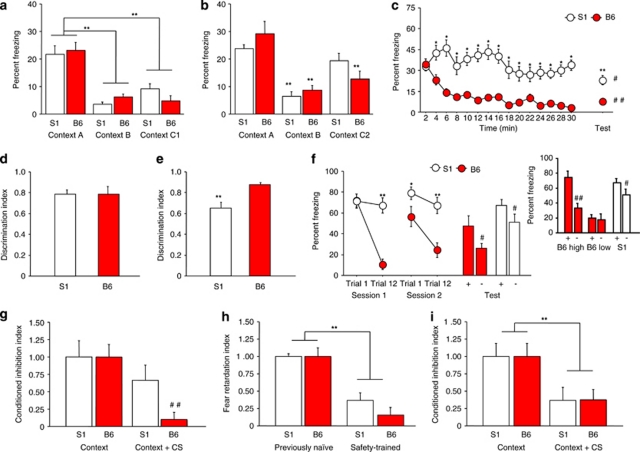Figure 1.
Fear overgeneralization and impaired safety learning. (a) S1 and B6 froze more to the conditioned context (Cxt A) than either a novel context (Cxt B) or slightly ambiguous context (Cxt C1) (**p<0.01 vs Cxt A, n=8 per strain). (b) S1 froze more to the conditioned Cxt (Cxt A) than a novel Cxt (Cxt B) but not a highly ambiguous context (Cxt C2). B6 froze more to Cxt A than either Cxt B or Cxt C2 (**p<0.01 vs Cxt A/same strain, n=8 per strain). (c) During Cxt extinction, there was a decrease in freezing from the first to the last timebin in B6 but not S1, and S1 froze more than B6 during all timebins except the first (*p<0.05 vs B6/same timepoint, n=16 per strain). During the extinction retrieval test S1 froze more than B6 (**p<0.01 vs B6), although freezing was lower than it was at the beginning of extinction training in S1 (#p<0.05) and B6 (##p<0.01). (d) S1 and B6 were equally able to discriminate a novel CS– from a conditioned CS+ (n=13–14 per strain). (e) S1 were poorer than B6 at discriminating a partially reinforced CS– from a fully reinforced CS+ (**p<0.01 vs B6, n=9–12 per strain). (f) S1 and B6 were equally able to discriminate a novel CS– from a conditioned CS+ after fear extinction, although discrimination in B6 was accounted for by a sub-population of poorly extinguishing mice (‘B6 high') (see inset) (*p<0.05, **p<0.01 vs B6, ##p<0.01 vs CS+/same strain, n=10–14 per strain). (g) Safety-trained B6, but not S1, showed inhibition of contextual fear during presentation of a CS safety signal (##p<0.01 vs Cxt/B6, n=9–10 per strain). (h) Safety-trained B6 and S1 mice showed retardation of new fear learning, as compared with previously naive controls (**p<0.01 vs previously naive, n=6–9 per strain per group). (i) Following safety training in which the CS block always preceded the US block, S1 and B6 both showed inhibition of contextual fear during presentation of the CS safety signal (**p<0.01 vs Cxt, n=7 per strain). Data are means±SEM.

